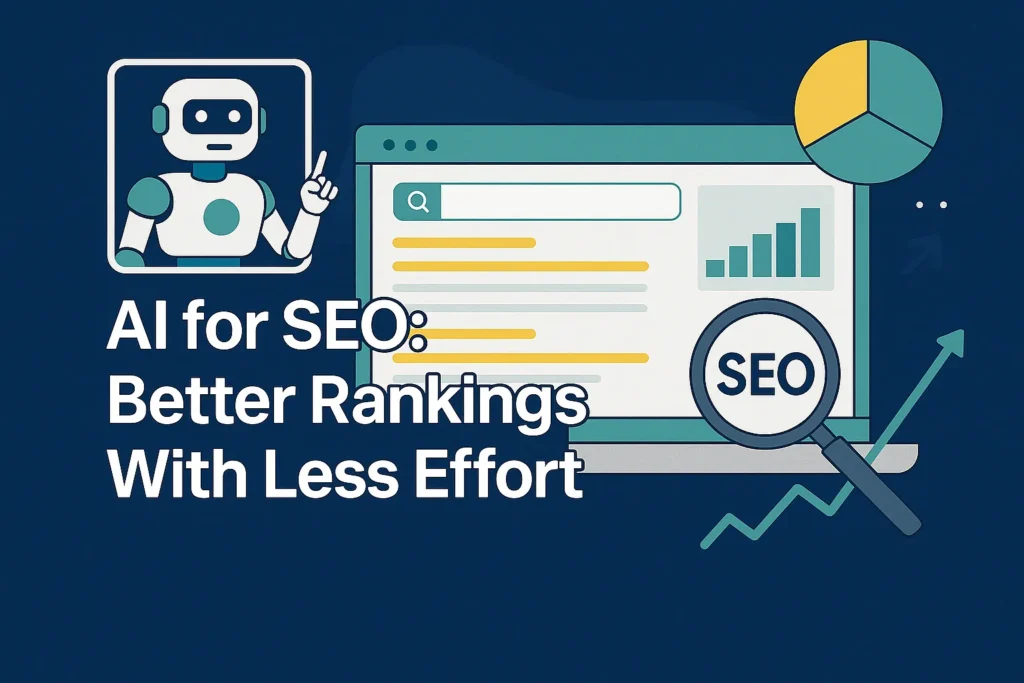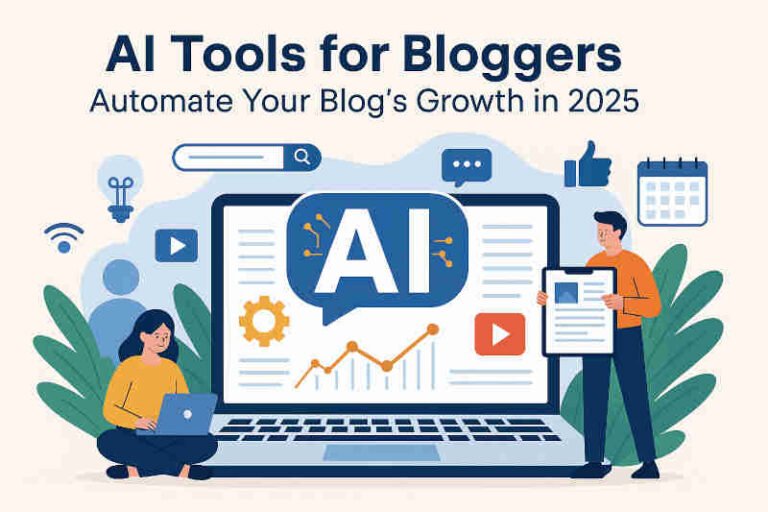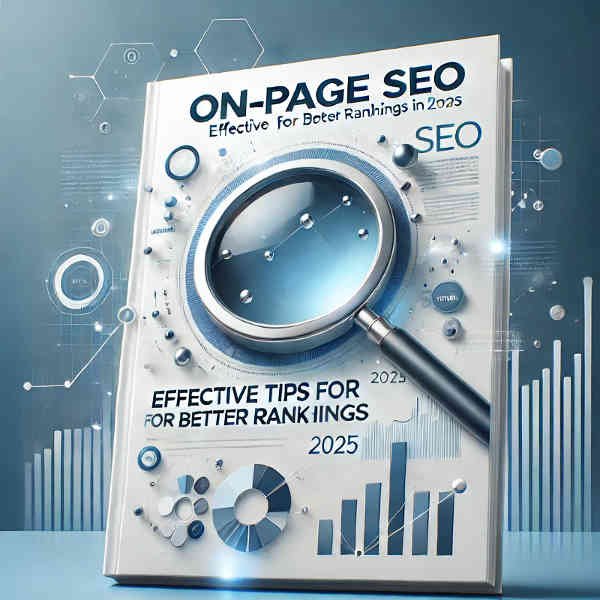AI for SEO: Better Rankings With Less Effort
Table of Contents
ToggleWe use affiliate links. If you purchase something using one of these links, we may receive compensation or commission.

Introduction
“Why work harder when AI can do the heavy lifting?”
That’s what I asked myself when I first heard about AI for SEO. I was skeptical at first—aren’t these tools just glorified keyword stuffers? Turns out, not even close. These days, AI can help me find ranking opportunities, generate optimized outlines, and even rewrite old blog posts to make them competitive again.
If you’re running a blog, building a niche site, or just trying to make sense of Google’s ever-shifting algorithm, AI tools can save you serious time—and headaches. In this article, I’ll walk you through how AI for SEO works, which tools are worth it, and the mistakes I wish someone had warned me about early on.
What Is AI for SEO and How Does It Work?
At its core, AI for SEO is about using machine learning to automate and improve search engine optimization tasks. Instead of doing everything manually—like sifting through keyword research, creating content briefs, or updating old posts—AI tools analyze data, understand patterns, and suggest smart actions.
These tools often rely on natural language processing (NLP) and semantic optimization. That means they don’t just count keywords; they try to understand what the content is about and how it matches user intent. For example, if you write a post about “best guitars for beginners,” a good AI SEO tool will recognize that terms like “starter guitars,” “easy to play,” and “budget-friendly” are semantically related.
So you’re not just writing for robots anymore. You’re working with them.
Best AI Tools for SEO Optimization in 2025
Let’s talk about some of the tools I’ve personally tested—or seen in action—and why they stand out:
Surfer SEO: This one’s a beast for content scoring. You paste in your article, and it tells you what you’re missing—keywords, headings, formatting—compared to top-ranking pages.
Frase: Probably the most intuitive tool I’ve used. It creates full content briefs from a single keyword, complete with SERP analysis, questions to answer, and headings to include.
NeuronWriter: Great for semantic writing. It’s like a content coach that nudges you toward better readability and coverage.
Outranking: This one is more advanced. It combines AI content creation with SEO optimization, and helps identify content gaps and opportunities.
RankIQ: Tailored for bloggers. It gives you easy-to-rank keyword suggestions and pre-built outlines. Super helpful if you’re short on time.
Others worth mentioning: Jasper, Writesonic, and of course, ChatGPT—especially when paired with plugins like AIPRM or SEO-optimized prompts.
Workflows That Save Time With AI for SEO
Once you get comfortable, you’ll realize how much these tools can simplify your life. Here are a few real-world workflows I use almost weekly:
Generate Outlines: I type in a keyword, and Frase or ChatGPT gives me a solid structure to work with. No more staring at a blank page.
Refresh Old Content: Outranking and Surfer help me spot underperforming articles. I run a quick audit, see what’s missing, and update accordingly.
Use Search Console Data: Combine Google Search Console with ChatGPT to create optimized content around keywords already generating impressions.
Automate Internal Links: Some tools (like Link Whisper) can suggest internal links based on context—huge for boosting SEO performance.
Plan Topic Clusters: AI clustering tools like Keyword Insights or MarketMuse let me map out related content and keep my site structure tight.
These workflows are perfect for both solo creators and small teams looking to scale.
Advantages and Limits of AI for SEO
Let’s not sugarcoat it—AI SEO tools are powerful. But they’re not miracle workers.
What’s great:
You can do more in less time. Keyword research that used to take hours? Now it’s minutes.
Your content quality goes up because you’re working off smart suggestions and content scoring.
You can scale easily without hiring a huge team.
But… here’s the catch:
You still need a human touch. AI doesn’t always understand tone, nuance, or your audience.
Over-automation can hurt. If you copy-paste AI-generated content without edits, you might run into duplicate content issues or miss the mark on intent.
Not every tool is affordable. Some of the best ones come with steep learning curves—or steep price tags.
So yes, use AI—but don’t hand over the keys completely.
Mistakes to Avoid When Using AI for SEO
Here are some mistakes I made early on (so you don’t have to):
Publishing unedited AI content. Big no-no. It sounds robotic, and Google’s smarter than you think.
Relying on outdated advice. SEO changes fast. Make sure your AI tool is trained on current SERP data—not old trends.
Forgetting about user intent. Just because a keyword is high volume doesn’t mean it fits what your article is about.
Overusing keywords. AI can sometimes suggest too many keyword variations. Keep it natural.
Ignoring layout and UX. Great content needs to look good too—headings, spacing, mobile optimization, all that jazz.
Is AI for SEO Worth It for Small Creators?
Short answer? Yes.
If you’re a solo blogger or small business owner, AI for SEO is like having a virtual assistant that never sleeps. You don’t need to outsource everything or burn out trying to rank content manually.
Some tools—like RankIQ or NeuronWriter—are under $50/month and can replace hours of research and planning. When I used Frase and Surfer to update five old blog posts, my organic traffic went up 38% in 6 weeks. Not life-changing, but proof that it works.
The real win is consistency. AI keeps you on track, even when motivation dips or you’re juggling other things.
Conclusion
AI for SEO isn’t a shortcut to the top—it’s a smarter way to get there. You still need strategy, creativity, and some patience. But with the right tools, the path becomes way smoother.
Start small. Pick one tool, apply it to a single blog post, and watch what happens. I’ve seen AI boost rankings, save time, and reduce stress. But it works best when paired with a human brain and a willingness to experiment.
Try it out—and let me know what tools or workflows you’ve found helpful. Because one thing’s for sure: the future of SEO is already here.






